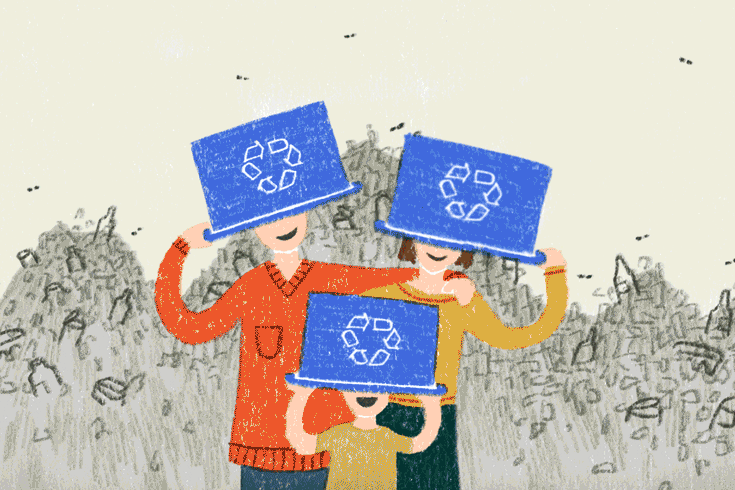Most Canadians know the ritual: check the pickup schedule, sort the waste items, clean the jars, make sure the junk mail isn’t stained with coffee grounds. Then fill up the blue box (or blue bag, or blue cart, depending on the city), and on the appointed day, haul it to the curb. It’s an activity that Canadians have participated in eagerly for almost thirty years. Of the three Rs drilled into our heads in school—reduce, reuse, recycle—recycling is the only one that most of us regularly practise. In 2011, according to a survey by Stewardship Ontario, three-quarters of Ontarians considered the weekly act of sorting and disposing as their “primary environmental effort.”
But as much as Canadians love the blue box, “its role in [our] hearts and minds…is much larger than its actual environmental impact,” wrote Dianne Saxe, Ontario’s environmental commissioner, in a report last October. In fact, recycling is one of the least environmentally friendly “environmental” things one can do.
After being picked up, enormous volumes of recyclable waste are unloaded at a local materials-recovery facility (MRF, pronounced like “smurf”), dumped onto conveyor belts, and passed through a battery of sieves, magnets, optical sorters, and manual workers who separate each item into its own stream—plastic, paper, metal, and so on. The batches from each stream are then sent to gigantic balers, squeezed into cubes, and sold, often by middleman companies, to “end markets.” These are the manufacturers, in Canada and around the world, that profit from turning our waste into something new—toilet paper, perhaps, or plastic lawn furniture, egg cartons, or drywall. More than a public service, recycling is largely a commodity business, as dependent on supply and demand as any other. When municipalities produce more recyclable garbage than end markets can absorb, the value of the product decreases, and in the selling market, Canada faces competition from countries across the world.
The limitations of a market-driven system mean that, once industrial- and commercial-waste streams are factored in, about two-thirds of Canadian waste still ends up in landfills.
It helps us feel better about the waste we produce: according to one estimate, 850 kilograms of garbage, per capita, every year.
When they were first introduced, blue boxes on Canadian driveways and sidewalks seemed almost revolutionary. People were “extremely enthusiastic,” says Dan Hoornweg, a professor at the University of Ontario Institute of Technology. They “really wanted to recycle.” But the box came with conditions—an unfortunate compromise between environmentalists, government, and the soft-drink industry that created the perfect conditions for an explosion in litter.
In mid-1980s Ontario, after years of arguments with the province, the soft-drink industry agreed to partially subsidize the blue box, which had been invented a few years earlier by a garbage collector in Kitchener, in exchange for being allowed to switch from refillable glass bottles to cheaper, disposable options. The deal helped create one of the world’s most popular residential-recycling programs, which soon began spreading nationwide. But it also gave industry a social licence to create one-time-use packaging—aluminum cans, yogurt containers, those plastic-wrapped cheese-and-cracker kits parents put in kids’ lunch boxes. In a sense, recycling became the preferred method for excusing wastefulness.
To make matters worse, almost two-thirds of Canada’s waste is produced by the industrial, commercial, institutional, and construction-and-demolition sectors—in everything from factories to office buildings—which are serviced by private waste haulers. Unless they can make a profit selling recyclables, which depends on market prices at the time of sale, there’s little incentive for these haulers to recycle. All of this means that you can put your takeout containers and shredded paper into the office recycling bin, but the company that takes it away is under no legal obligation to recycle it. In Toronto, for example, 72 percent of waste material from apartment and condo buildings goes straight to a landfill.
Ontario is the only province from which detailed financials are available. In 2016, blue-box collection cost municipalities a total of $347 million, and only about $95 million was recovered from subsequent sales. The rest of the bill was split between the municipality and industry. The idea, early on, was that sales of recyclables on the open market would pay in full for recycling programs. That, of course, never happened. Our blue boxes contain a lot of “lightweight, complicated materials that cost a fortune to recycle,” Saxe says. Whenever a confused resident places an unrecyclable item (say, a plastic-lined takeout coffee cup) into their box, it only aggravates the situation. “You basically end up paying to process [the item] twice,” says Jim McKay, who oversees Toronto’s solid-waste management services: once as recycling, at the MRF, and once as garbage. In the end, according to Saxe’s report, the blue box diverts only 8 percent of Ontario’s material from landfills. Other provinces, with fewer homes served by curbside pickup, probably recycle even less.
Residential recycling itself also comes with a significant environmental footprint of its own, especially tied to transportation and carbon emissions. In some circumstances, recycling could actually end up as an environmental liability. “In rural areas you have trucks going half a kilometre between houses picking up recyclables,” Hoornweg says. “It makes no sense.” Once you tally up the emissions associated with picking up products, sorting them at a MRF, and sending a batch to far-flung end markets, it’s not difficult to imagine that it’s sometimes better to send recycling to the dump.
This january, China declared war against yang laji (“foreign garbage”). After decades of purchasing recycling that was cluttered with undesirable objects, such as greasy pizza boxes, the country set strict cleanliness standards for the material it purchases. The announcement sent the global industry into a frenzy: for decades, China had been the end market for more than half of the world’s plastic and paper, which are used as raw materials in Chinese building and manufacturing. Many of the Canadian outfitters that relied on China were left stranded because they couldn’t guarantee the quality of their product.
The effects were immediate: exports of plastics and scraps to China fell from 6,700 tonnes in January 2017 to 578 one year later. Paper-scrap exports fell from 53,000 to 15,800 tonnes. Some of that leftover material is finding its way to other foreign markets, mostly in southeast Asia and India. Some of it is ending up in landfills. Halifax has resorted to burning its plastics in waste-to-energy facilities. And, as of this May, Calgary was still storing more than 7,500 tonnes of paper. At that time, the city also hadn’t been able to find buyers for 1,000 tonnes of clamshell plastics—the little containers berries come in. “They’re laminated and covered in adhesive labels,” says Sharon Howland, Calgary’s leader of program management for waste and recycling. “Nobody wants them.”
China’s ban forced many of us to confront the realities of a broken system. Canada is good at touting its green conscience; sacrificing comfort, convenience, and habit is a different matter. Yes, Justin Trudeau signed the Paris climate agreement in 2016, promising to reduce greenhouse-gas emissions by 30 percent from 2005 levels by 2030. But still, road pollution in the country is rising. Whenever gas prices drop, oil-sands projects slow down—which could be seen as environmental progress. But we also then buy bigger, less-fuel-efficient cars. And Canada is lagging behind most other industrialized countries when it comes to electric-vehicle purchases.
The same problem can be seen with the blue box: we cling to our good intentions, but we seldom carry them out. We have always produced far more garbage than we could offload to end markets. Increasingly, our MRFs—and our streets, streams, and oceans—are overflowing with waste.
Saxe’s Beyond the Blue Box report was presented to Ontario’s legislature last fall, as the province was considering a sea change in its approach to garbage: a “circular economy” in which industry would be responsible for products’ post-consumer life and manufacturing would become a closed loop in which as much as possible is reused, in perpetuity, to create new products. But while Ontario passed the Waste Free Ontario Act in 2016, it provides only a guiding framework for this hypothetical future, with very few details and no concrete plan of action. “It’s certainly a great ambition to imagine this path forward,” Saxe says. “But it will clearly be very, very difficult.” The act’s success is entirely dependent on regulations yet to come, making it, at this point, little more than good intentions. Today, with a premier intent on rolling back the previous government’s environmental initiatives (also including the province’s cap-and-trade carbon-pricing measures) a waste-free future looks doubtful.
Recycling alone will likely never be enough to make up for the garbage we produce. The fight, thirty years ago, to keep Canadians’ fizzy drinks in refillable glass bottles was a good thing to do all along. Making coffee the old-fashioned way is better than cycling through millions of single-use coffee pods. And yet most people who’ve spent their careers in waste management continue to encourage recycling—it’s better than nothing. And Canadians love it because it’s something each and every one of us can control: sort, clean, and carry to the curb.





